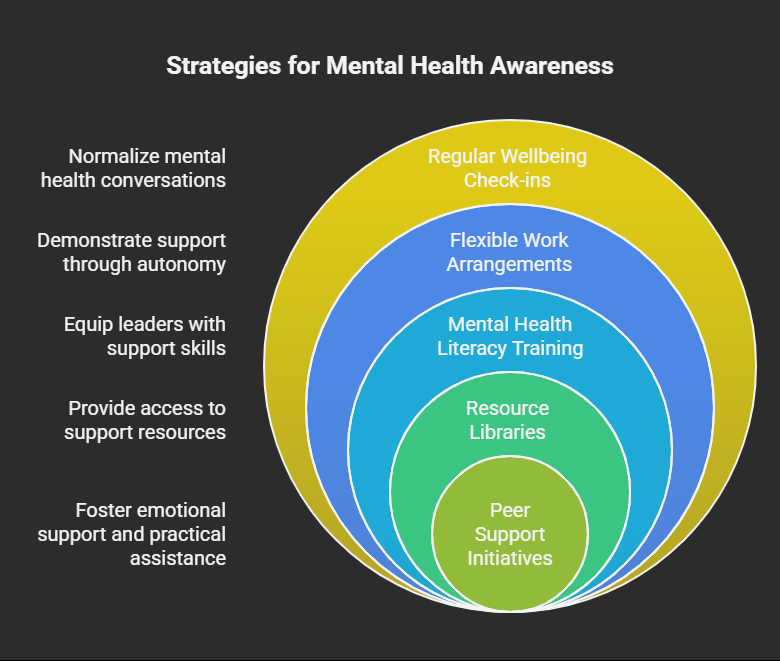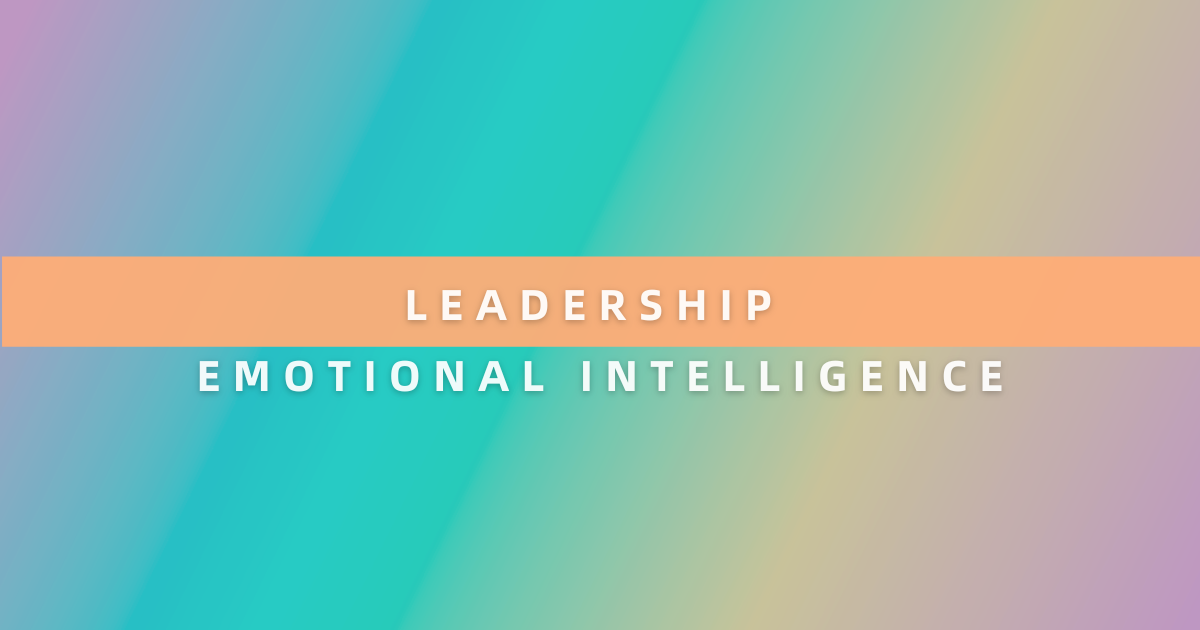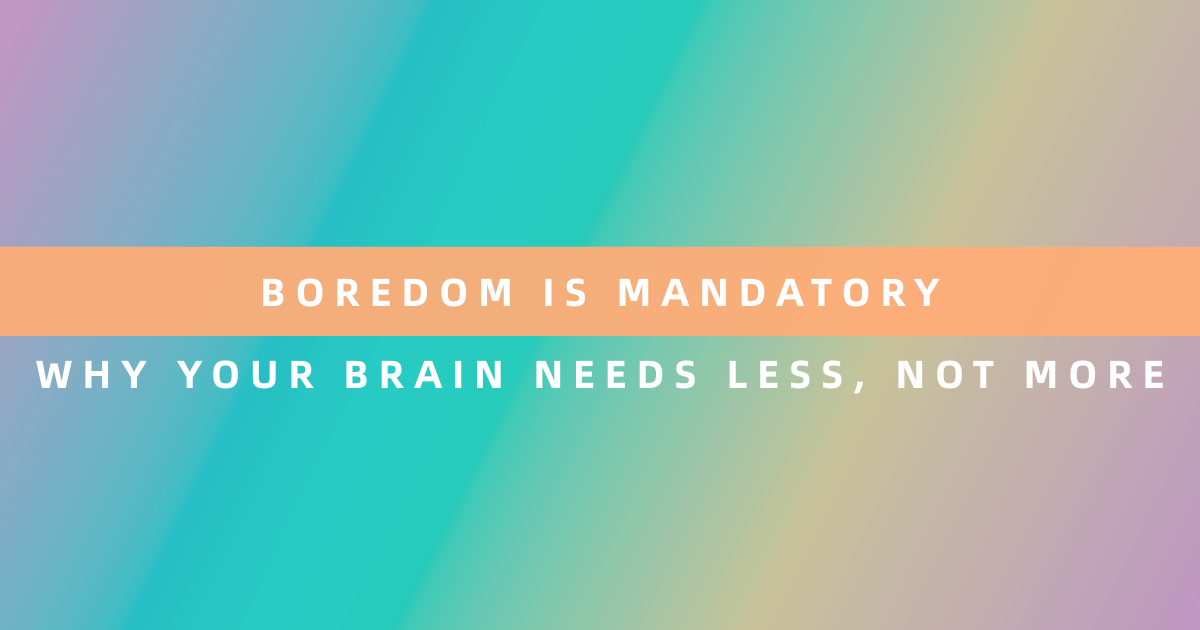The World Health Organization confirms that investments in mental health treatment yield significant returns in improved health and productivity [1]. Despite clear evidence of these benefits, many organizations struggle to create mentally healthy workplaces. Research consistently points to one critical factor: the emotional intelligence of leaders and their ability to model mental health awareness.
Research indicates that managers have a significant impact on employee engagement and well-being [2]. As workplaces evolve beyond traditional hierarchies, the ability to recognize, understand, and manage emotions becomes essential for organizational success. Leaders who demonstrate these capabilities create environments where employees thrive both personally and professionally.
The Link Between Leadership and Mental Health
Workplace stress affects most employees. Recent research by PubMed indicates that this leads to emotional exhaustion, decreased motivation, and a desire to leave one’s job [3]. However, there’s a clear upside. When employees feel supported by emotionally intelligent leaders, they experience much less burnout and report higher job satisfaction. This direct link between a leader’s approach and their team’s well-being has become incredibly clear over decades of organizational research.

This connection isn’t simple. It works on many different levels. Studies demonstrate strong links between supportive leadership behaviors and less employee stress [4]. When leaders show genuine care and understanding, it creates positive ripple effects across the whole team. On the other hand, leadership styles that are dismissive or emotionally distant only make workplace stress worse and contribute to mental health issues. Neuroscience offers some really interesting insights into these dynamics. Brain imaging studies show that employees’ brain responses to different leadership styles directly impact their stress hormones, how well they think, and their ability to manage emotions. When leaders show empathy and emotional awareness, it lights up neural pathways in their team members connected to trust and safety. This biological response isn’t just theoretical. It translates into better focus, more creativity, and an overall sense of well-being.
Old-school, command-and-control leadership that puts authority over connection has been proven to increase stress responses and hurt performance. Modern research strongly supports emotionally intelligent leadership that focuses on understanding and collaboration. This shift reflects a growing understanding that truly sustainable high performance requires us to pay attention to human needs right alongside business goals.
The Business Case for Emotionally Intelligent Leadership
Companies with genuinely engaged workforces consistently outpace their competitors when it comes to profitability, productivity, and customer satisfaction. Given that employee engagement largely hinges on the quality of leadership, pouring resources into developing emotional intelligence for leaders absolutely delivers measurable returns.
As discussed earlier, studies show that a leader’s behavior is actually the main reason people decide to leave a company. And when you consider that replacing an employee can easily cost anywhere from half to double their annual salary, the financial hit from ineffective leadership is just massive. Organizations with emotionally intelligent leaders, though, see significantly lower turnover rates. That translates directly into huge cost savings and means they get to keep all that valuable knowledge within the company.
Employee well-being also has a direct impact on healthcare costs and overall productivity. Research also proves that stressed employees rack up noticeably higher healthcare expenses than their less-stressed peers [5]. Companies that put in place comprehensive well-being programs, especially when those are spearheaded by emotionally aware managers, report a solid return on investment through reduced healthcare costs and improved productivity.
Beyond the financials, innovation and adaptability thrive under emotionally intelligent leadership. Teams that feel truly psychologically safe (which is a direct result of supportive leadership) show greater creativity, solve problems faster, and handle change initiatives with more success. This is becoming increasingly important as organizations navigate today’s rapid technological and market shifts, which demand constant adaptation.
The benefits even extend beyond internal numbers to how customers experience things. Employees who feel supported and valued by their leaders deliver far superior customer experiences. This creates a positive cycle where a strong internal culture drives external success, reinforcing the undeniable business case for investing in leadership emotional intelligence.
Core Components of Mental Health Aware Leadership
Daniel Goleman’s well-established emotional intelligence framework, which has been proven effective in thousands of organizations, outlines four crucial areas for leaders who truly want to champion mental health [6]. These core components include:
- – Self-Awareness
- – Self-Management
- – Social Awareness
- – Relationship Management
Self-awareness is the absolute bedrock here. Leaders need to genuinely understand their own emotions, recognize what triggers them, and acknowledge the ripple effect they have on others. Leaders strong in self-awareness build more authentic connections and naturally model emotional honesty for their teams.
Self-management involves regulating emotions effectively, particularly during stressful situations. This doesn’t mean suppressing emotions but rather expressing them appropriately and maintaining composure when teams need stability.
Then there’s Social Awareness, particularly empathy. This directly impacts your team’s mental well-being. When leaders truly understand and respond to their team members’ emotional experiences, it creates a workplace where people feel genuinely valued and supported. This kind of emotional understanding helps leaders spot when employees might be struggling and step in with timely support before small issues become big problems.
Relationship Management covers the skills you need to influence, coach, and inspire, all while keeping healthy boundaries in place. Effective relationship management means you can navigate difficult conversations with compassion, offer feedback that helps people grow, and build connections that support both strong performance and overall well-being.
Beyond these core components, leaders who are truly mental health aware also need to understand trauma-informed approaches. Many employees carry past traumas that undeniably shape their workplace experience. Leaders who can recognize trauma responses and react with patience and understanding create safer spaces where healing and growth are possible. This particular awareness becomes even more vital in high-stress industries or during significant organizational shifts.
Practical Strategies for Modeling Mental Health Awareness
Regular well-being check-ins represent one of the most effective strategies for normalizing mental health conversations. Research indicates that brief, consistent discussions about workload, stress, and support needs create psychological safety over time [7]. These conversations need not be lengthy or formal; even five-minute check-ins during regular meetings can make substantial differences in team dynamics.

Flexible work arrangements demonstrate concrete support for diverse mental health needs. The pandemic proved that many roles can be performed effectively with greater autonomy over when and where work happens. Leaders who model flexibility, whether by working from home when needed or respecting others’ schedule preferences, signal that well-being matters as much as productivity.
Mental health literacy training equips leaders with practical skills for supporting their teams. Understanding common mental health challenges, recognizing warning signs, and knowing how to respond appropriately helps leaders provide better support. Organizations offering such training report improvements in early intervention and reduced crises.
Creating and maintaining resource libraries ensures employees can access support when needed. Leaders who curate and regularly reference mental health resources, from stress management apps to employee assistance programs, remove stigma and encourage help-seeking behaviors. Personal endorsement from leadership significantly increases resource utilization.
Peer support initiatives championed by leadership create additional layers of support beyond formal reporting structures. Whether through mentorship programs, employee resource groups, or informal buddy systems, peer connections provide valuable emotional support and practical assistance. Leaders who participate in and advocate for these programs demonstrate that seeking support is a sign of strength, not weakness.
Creating Psychological Safety Through Leadership
Amy Edmondson’s groundbreaking research at Harvard defines psychological safety as the shared belief that teams can take interpersonal risks without fear of punishment or humiliation. This concept has proven fundamental to team performance, innovation, and mental health. Google’s extensive research confirmed that psychological safety represents the single most important factor in team effectiveness.
Creating psychological safety requires consistent leadership behaviors that build trust over time. Leaders must respond to mistakes with curiosity rather than blame, encouraging learning from failures rather than hiding them. This approach reduces anxiety around perfectionism and allows teams to experiment, innovate, and grow without fear of retribution.
Inclusive leadership practices ensure all voices are heard and valued. When leaders actively seek input from quieter team members, acknowledge different perspectives, and create space for respectful disagreement, they build environments where diversity thrives. This inclusivity particularly benefits employees who might otherwise feel marginalized, improving both their mental health and their contributions.
Maintaining confidentiality when employees share personal challenges proves essential for psychological safety. Leaders must communicate what information remains private and what might need to be shared for safety or legal reasons. This transparency helps employees make informed decisions about disclosure while knowing their privacy will be respected.
Celebrating growth and vulnerability reinforces psychological safety. When leaders publicly acknowledge team members for admitting mistakes, seeking help, or trying new approaches, they signal that these behaviors are valued. This positive reinforcement encourages others to take similar risks, creating cultures of continuous learning and mutual support.
Measuring the Impact of Emotionally Intelligent Leadership
Assessing leadership emotional intelligence requires comprehensive approaches beyond traditional performance metrics. Multi-source feedback systems, including input from supervisors, peers, and direct reports, provide holistic views of leadership effectiveness. Regular pulse surveys can track changes in team morale, stress levels, and perceived support over time.
Employee engagement surveys offer valuable insights into leadership impact. Well-validated instruments measure factors like commitment, satisfaction, and discretionary effort, all strongly influenced by leadership quality. Tracking engagement trends helps identify which leadership behaviors most affect team wellbeing and performance.
Turnover and retention metrics provide concrete evidence of leadership effectiveness. Departments with emotionally intelligent leaders typically experience lower voluntary turnover, reduced absenteeism, and fewer stress-related leave requests. These improvements translate directly into cost savings and productivity gains that justify investments in leadership development.
Healthcare utilization data from employee assistance programs offers another measurement avenue. Increased utilization often indicates successful destigmatization efforts, while usage patterns can highlight areas needing additional support. Teams with emotionally intelligent leaders often show higher preventive service use but lower crisis intervention needs.
Performance indicators beyond traditional metrics reveal the full impact of emotional intelligence. Customer satisfaction scores, innovation metrics, and quality measures often improve under emotionally intelligent leadership. These improvements persist even when controlling for other factors, indicating that emotional intelligence independently drives performance across multiple dimensions.
Common Challenges and Solutions
Resistance to emotional intelligence development often stems from misconceptions about “soft skills” being less important than technical expertise. However, research consistently shows that emotional intelligence becomes increasingly important at higher leadership levels. Overcoming this resistance requires presenting compelling evidence linking emotional intelligence to concrete business outcomes relevant to skeptics’ priorities.
Time constraints represent a common barrier to implementing mental health awareness practices. Leaders often feel overwhelmed by existing responsibilities without adding wellbeing initiatives. The solution lies in integrating mental health considerations into existing processes rather than creating separate programs. Brief check-ins during regular meetings, wellness considerations in project planning, and modeling healthy boundaries require minimal additional time while yielding substantial benefits.
Cultural barriers vary significantly across industries and regions. Some organizational cultures view emotional expression as a weakness or mental health discussions as inappropriate for work. Successful approaches start with universally acceptable concepts like stress management or work-life balance, gradually expanding conversations as comfort levels increase. Finding cultural champions who can advocate from within proves particularly effective.
Limited resources challenge many organizations, particularly smaller companies without dedicated wellness budgets. Cost-effective interventions include peer support programs, manager training workshops, and free or low-cost digital resources. Many impactful strategies require more intention than investment, such as regular check-ins, flexible scheduling, and creating supportive team cultures.
Sustaining momentum beyond initial enthusiasm presents ongoing challenges. Many well-intentioned initiatives fade when champions leave or priorities shift. Building sustainability requires embedding mental health awareness into organizational systems, creating accountability mechanisms, and regularly communicating value to maintain support. Success depends on making mental health awareness part of organizational DNA rather than a temporary initiative.
Building Sustainable Mental Health Leadership Practices
Creating lasting change requires systematic approaches beyond individual leader efforts. Organizations must develop comprehensive frameworks that explicitly include emotional intelligence and mental health awareness in leadership competencies. These frameworks guide hiring decisions, performance evaluations, and development opportunities, ensuring consistent expectations across all leadership levels.
Succession planning must consider emotional intelligence alongside technical qualifications. Identifying and developing future leaders who demonstrate natural emotional awareness ensures continuity of supportive cultures through leadership transitions. This might include mentorship programs pairing emotionally intelligent leaders with high-potential employees, creating experiential learning opportunities.
Integration with business strategy prevents mental health initiatives from becoming isolated programs. When organizations link wellbeing metrics to strategic objectives, mental health awareness gains equal status with financial and operational goals. Regular reviews of how mental health impacts key performance indicators maintain executive attention and resource allocation.
External partnerships amplify internal efforts. Collaborating with mental health professionals, academic institutions, and specialized consultants brings expertise and credibility to initiatives. These partnerships provide evidence-based approaches, program evaluation capabilities, and connections to broader mental health communities.
Technology solutions can scale mental health support efficiently. Digital platforms offer consistent resources across distributed teams while providing data insights to guide interventions. AI-powered tools can identify concerning patterns in team communications or engagement, enabling proactive support. However, technology should supplement rather than replace human connection and leadership involvement.
Make Your Leadership Count
When it comes down to it, a healthy mental health culture in your organization starts and ends with strong, committed leadership. It’s not just about a program; it’s about how leaders genuinely show up every day.
That’s precisely where Theryo.ai comes in. Our AI-enhanced platform gives leaders the specific tools and insights they need to foster workplaces that are not just psychologically safe, but also truly high-performing. We offer a collaborative approach that brings together smart assessments, tailored development resources, and clear team analytics. It’s all built to genuinely support leaders on their journey to master emotional intelligence.
If you’re ready to make a real difference and visibly champion mental health awareness in your organization, we invite you to learn more. See how our platform helps cultivate a place where both your people and your business can truly thrive. Visit Theryo.ai today.
Frequently Asked Questions
What exactly is emotional intelligence in leadership?
Emotional intelligence in leadership encompasses four interconnected domains that enable effective people management. Self-awareness involves recognizing your own emotions and understanding how they affect your behavior and impact on others. Self-management means regulating your emotional responses, especially during stressful situations, to maintain composure and make thoughtful decisions. Social awareness, particularly empathy, enables leaders to understand and respond appropriately to others’ emotional states and needs. Relationship management combines these elements to build strong connections, navigate difficult conversations, and inspire teams toward shared goals. Research consistently shows that leaders who develop these capabilities create more engaged, productive, and mentally healthy teams.
How can leaders start mental health conversations without making employees uncomfortable?
Starting mental health conversations requires creating natural, low-pressure opportunities for dialogue. Successful approaches focus on work-related stressors rather than personal diagnoses. Leaders might begin team meetings by acknowledging challenging periods or high workloads, then asking how everyone is managing. Using open-ended questions about energy levels, work-life balance, or support needs opens doors without forcing disclosure. Regular check-ins normalized over time make these conversations feel routine rather than exceptional. The key is consistency and genuine concern rather than scripted interactions. Leaders who share their stress management strategies or challenges (appropriately) often find team members more willing to engage authentically.
What are the signs that a team lacks psychological safety?
Teams lacking psychological safety exhibit predictable patterns that observant leaders can identify. Meeting dynamics often reveal the most obvious signs: team members rarely voice dissenting opinions, discussions feel scripted or superficial, and the same few people dominate conversations. When mistakes occur, finger-pointing and blame-shifting become common rather than collaborative problem-solving. Innovation stagnates as team members avoid proposing new ideas that might fail. You might notice increased formality in communications, with people choosing written documentation over verbal discussions to protect themselves. Stress-related absences increase, and talented employees begin leaving for “better opportunities” that often simply offer safer environments.
How do you balance mental health support with maintaining performance standards?
Balancing mental health support with performance requires reframing the relationship between well-being and productivity. Research consistently shows that supporting employee mental health enhances rather than compromises performance. The key lies in maintaining clear expectations while providing flexibility in how goals are achieved. This might mean allowing adjusted schedules for therapy appointments while maintaining project deadlines, or providing additional resources during challenging periods rather than lowering standards. Successful leaders focus on sustainable performance over time rather than short-term output at any cost. They recognize that brief accommodations often prevent extended absences, and that employees who feel supported typically exceed expectations once they’ve addressed their challenges.
What if senior leadership doesn’t support mental health initiatives?
When senior leadership resists mental health initiatives, change agents must adopt strategic approaches. Start by implementing small changes within your sphere of influence and documenting results. Focus on business metrics that resonate with executives: productivity improvements, reduced turnover costs, lower absenteeism rates, and enhanced team performance. Partner with HR or other supportive departments to access organizational data that demonstrates the impact of your team-level initiatives. Share success stories from similar organizations or industries. Sometimes, grassroots change that delivers measurable results influences senior leadership more effectively than top-down mandates. Building coalitions with other middle managers can amplify your impact and create momentum for broader organizational change.
How can remote leaders demonstrate emotional intelligence and mental health awareness?
Remote leadership requires intentional strategies to maintain human connection across digital channels. Successful remote leaders schedule more frequent one-on-one check-ins than they might in person, recognizing that casual hallway conversations no longer happen naturally. Video calls for important discussions help capture non-verbal cues that reveal emotional states. Creating virtual spaces for informal interaction, optional coffee chats, virtual lunch sessions, or team-building activities maintains social connections. Respecting time zones and personal schedules demonstrates consideration for work-life balance. Asynchronous communication tools allow team members to engage when they’re at their best rather than forcing real-time responses. Most importantly, remote leaders must model healthy boundaries by truly disconnecting outside work hours.
What role does vulnerability play in leadership, and how much is too much?
Strategic vulnerability in leadership builds trust and connection when used appropriately. Effective vulnerability might include admitting when you don’t have all the answers, sharing lessons learned from past failures, or acknowledging the emotional impact of organizational changes. This authenticity helps team members see leaders as human and approachable. However, boundaries remain crucial. Using your team as therapy, sharing active personal crises in detail, or consistently focusing conversations on your challenges crosses into inappropriate territory. The litmus test: Does sharing this information benefit the team’s growth or understanding? Vulnerability should open doors for others rather than burden them with your unresolved issues.
How do you measure the ROI of emotional intelligence training for leaders?
Measuring emotional intelligence training ROI requires tracking multiple indicators over time. Start with baseline measurements of employee engagement, turnover rates, and team performance metrics before training begins. Post-training, monitor these same indicators quarterly to identify trends. Additional metrics might include 360-degree feedback scores, employee satisfaction ratings, and stress-related absence rates. Customer satisfaction scores often improve as team morale increases. Calculate direct cost savings from reduced turnover and absenteeism, then factor in productivity improvements and enhanced innovation. While some benefits remain difficult to quantify precisely, the combination of hard metrics and qualitative improvements typically demonstrates substantial returns on emotional intelligence investments.
What are the common mistakes leaders make when trying to support employee mental health?
Leaders often make predictable errors when first attempting to support employee mental health. One common mistake involves implementing surface-level wellness programs, yoga classes, or meditation apps, without addressing systemic issues causing stress. Another frequent error is breaking confidentiality, even with good intentions, which destroys trust and discourages future disclosures. Some leaders assume they know what employees need without asking, leading to misaligned initiatives. Others address mental health only during crises rather than maintaining a consistent preventive focus. Showing favoritism toward employees without visible struggles while being impatient with those facing challenges creates toxic dynamics. The overarching mistake is treating mental health as an individual problem rather than considering organizational factors.
How can leaders support mental health while respecting cultural differences in their teams?
Supporting mental health across cultural differences requires education, sensitivity, and flexibility. Different cultures have varying attitudes toward mental health, emotional expression, and help-seeking behaviors. Successful leaders educate themselves about these differences without making assumptions about individuals based on cultural backgrounds. They offer multiple support pathways; some may prefer individual counseling, while others find group support or physical wellness activities more culturally acceptable. Using inclusive language that doesn’t pathologize different coping strategies shows respect. Partnering with cultural community organizations can provide appropriate resources and build trust. Anonymous support options often see higher utilization in cultures with strong mental health stigma. Most importantly, leaders should ask team members what support would be most helpful rather than imposing one-size-fits-all solutions.
References
[1] https://www.who.int/news/item/13-04-2016-investing-in-treatment-for-depression
[2] https://bonusly.com/post/managers-impact-on-your-bottom-line
[3] https://pmc.ncbi.nlm.nih.gov/articles/PMC9368148/
[4] https://www.researchgate.net/publication/387507410_Impact_of_Supportive_Leadership
[5]https://www.researchgate.net/publication/276857841
[6]https://crm.glp.earth/index.jsp/4451465/WorkingWithEmotionalIntelligenceDanielGoleman.pdf
[7]https://cclinnovation.org/wp-content/uploads/2022/05/psychologicallysafe.pdf







